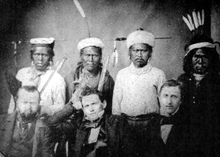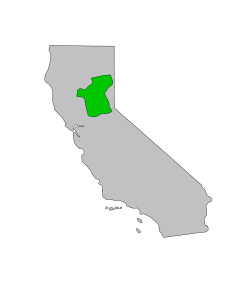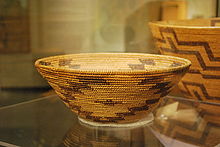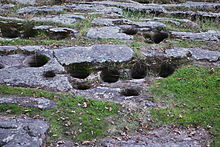- Maidu
-
Maidu Total population 2,500[1] Regions with significant populations United States of America (CA) Languages Religion Christianity (incl. syncretistic forms), other
The Maidu are a group of Native Americans who live in Northern California. They reside in the central Sierra Nevada, in the drainage area of the Feather and American Rivers. In Maiduan languages, Maidu means "person".
Contents
Local divisions
There are three subcategories of Maidu:
- The Nisenan or Southern Maidu occupied the whole of the American, Bear and Yuba River drainages. They live in lands that were previously home to the Martis.[2]
- The Northeastern or Mountain Maidu, also known as Yamonee Maidu, lived on the upper North and Middle forks of the Feather River.
- The Konkow (Koyangk'auwi/Concow) or Northwestern Maidu lived below the high Sierra, in the South, Middle, North and West branches of the Feather River, on the Upper Butte and Chico Creeks, and in the Sacramento Valley along the lower course of those streams.
Population
 Original title: Maidu Headmen with Treaty Commissioners. Treaty Commissioner O. M. Wozencraft is seated center front. Image was captured on or around August 1, 1851 at Bidwell's Ranch at Chico Creek.
Original title: Maidu Headmen with Treaty Commissioners. Treaty Commissioner O. M. Wozencraft is seated center front. Image was captured on or around August 1, 1851 at Bidwell's Ranch at Chico Creek.
Estimates for the pre-contact populations of most native groups in California have varied substantially. (See Population of Native California.) Alfred L. Kroeber (1925:883) estimated the 1770 population of the Maidu (including the Konkow and Nisenan) as 9,000. Sherburne F. Cook (1976:179) raised this figure slightly, to 9,500.
Kroeber reported the population of the Maidu in 1910 as 1,100. The 1930 census counted only 93. As of 1995, the Maidu population had recovered to an estimated 3,500.
Culture
The Maidu were hunters and gatherers.
The Maidu were exemplary basket makers, weaving highly detailed and useful baskets in sizes ranging from thimble-sized to huge ones ten or more feet in diameter. The stitches on some of these baskets are so fine that you need a magnifying glass to see them. In addition to closely woven, watertight baskets for cooking, they made large storage baskets, bowls, shallow trays, traps, cradles, hats and seed beaters. To make these baskets they used dozens of different kinds of wild plant stems, barks, roots and leaves. Some of the more common were fern roots, red bark of the redbud, white willow twigs and tule roots, hazel twigs, yucca leaves, brown marsh grass roots and sedge roots. By combining these different kinds of plants, they were able to make geometric designs on their baskets in red, black, white, brown or tan.
Subsistence
Although the Maidu were hunters and gatherers and did not farm, like many other California tribes they practiced grooming of their gathering grounds, with fire as a primary tool for this purpose, and tended local groves of oak trees to maximize production of acorns, which was their principal dietary staple. The abundance of acorns made it possible for the Maidu to store large quantities for harder times, and they used their basket-making skills to construct above-ground acorn granaries.
Besides acorns, which provided dietary starch and fat, the Maidu lived in an environment rich in plant and animal life, much of it edible, and they supplemented their acorn diet with edible roots (for which they were nicknamed "Digger Indians" by European immigrants), fish from the many streams and rivers, and other plant and animal species.
Housing
Maidu housing, especially higher in the hills and the mountains, was largely semi-underground. These underground houses were sizable, circular structures twenty to forty feet in diameter, whose floors were as much as three feet below ground level. Once the floor of the house was dug, a pole and log framework was built, upon which a heavy layer of earth was placed. With a central fire in the house, this made for good warmth in the winter. For summer dwelling, a different structure was built from cut branches tied together and fastened to sapling posts, then covered with brush and dirt. The summer shelters were built with the principal opening facing east to catch the rising sun, and to escape the heat of the afternoon.
Social organization
They lived in small villages or tribelets with no centralized political organization. Leaders were typically selected from the pool of men who headed the local Kuksu cult, but generally did not exercise day-to-day authority, being primarily responsible for settling internal disputes, and negotiating over matters arising between villages.
Religion
The primary religious tradition of the Maidu revolved around the Kuksu cult, which was a central California religious cult system based on a male secret society and characterized by the Kuksu or "big head" dances. Besides the Maidu, this cult system was also followed by the Pomo and the Patwin among the Wintun.
Languages
The Maidu spoke a language held by some authorities to be of the Penutian linguistic stock. While all Maidu spoke a form of this language, the grammar, syntax and vocabulary differed sufficiently that Maidu separated by large distances or by geographic features that discouraged travel might actually speak nearly mutually unintelligible dialects of the tongue.
There were four principal divisions of the language: Northeastern Maidu, Yamonee Maidu (known simply as Maidu); Southern Maidu or Nisenan; Northwestern Maidu or Konkow; and Valley Maidu or Chico.
U.S. federally recognized tribes
- Berry Creek Rancheria of Maidu Indians
- Enterprise Rancheria of Maidu Indians of California
- Greenville Rancheria of Maidu Indians of California
- Mechoopda Indian Tribe of Chico Rancheria
- Mooretown Rancheria of Maidu Indians of California
- Shingle Springs Band of Miwok Indians, Shingle Springs Rancheria (Verona Tract)
- Susanville Indian Rancheria
- United Auburn Indian Community of the Auburn Rancheria
Non-federally recognized tribes
- Honey Lake Maidu Tribe
- KonKow Valley Band of Maidu Indians[3]
- Nevada City Rancheria
- Strawberry Valley Rancheria
- Tsi Akim Maidu Tribe of Taylorsville Rancheria
- United Maidu Nation
- Colfax-Todds Valley Consolidated Tribe of the Colfax Rancheria
Contemporary artists
- Dalbert Castro – Nisenan
- Frank Day – Konkow
- Harry Fonseca – Nisenan
- Judith Lowry – Mt. Maidu
- Frank Tuttle[4] – Koncow Maidu
- Janice Gould – Konkow Maidu
Traditional narratives
Stories of the Trickster Coyote were particularly prominent[citation needed].
References
- ^ "California Indians and their Reservations." SDSU Library and Information Access. (retrieved 2 Sept 2010)
- ^ Robbins, John (2000-12-14). "ACTION: Native American human remains and associated funerary objects:". thefederalregister.com. http://www.thefederalregister.com/d.p/2000-12-22-00-32660. Retrieved 2008-08-14.
- ^ Konkow Valley Band of Maidu
- ^ Frank Tuttle (Konkow Maidu, Yuki, Wailaki)
Sources
- Cook, Sherburne F. 1976. The Conflict between the California Indian and White Civilization. University of California Press, Berkeley.
- Kroeber, A. L. 1925. Handbook of the Indians of California. Bureau of American Ethnology Bulletin No. 78. Washington, D.C.
- Heizer, Robert F. 1966. Languages, Territories, and Names of California Indian Tribes. University of California Press, Berkeley.
- Pritzker, Barry. 2000. A Native American Encyclopedia: History, Culture, and Peoples. Oxford University Press, New York.
External links
Categories:- Maidu
- Native American tribes in California
Wikimedia Foundation. 2010.



